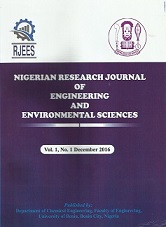Assessment of Polycyclic Aromatic Hydrocarbons in Water and Sediments of Allor River in Ankpa Local Government Area of Kogi State, Nigeria
Authors: *Ejukwa, E.E., Ameh, E.M., Okpanachi, C.B., Adukwu, E.G., Omale, S. And Umar, A.Y.
DOI Info: http://doi.org/10.5281/zenodo.15778262
ABSTRACT
The distribution of the sixteen polycyclic aromatic hydrocarbons (PAHs) was studied in the upstream, mid-stream and lower stream of surface water and sediments of Allor River in Anpka Local Government Area of Kogi State, Nigeria. Liquid-liquid extraction was used for water samples, while PAHs in sediments were extracted using Liquid-Solid Extraction and finally analyzed by means of gas chromatography equipped with a flame ionization detection. Results showed that in water samples, the highest concentration was related to acenaphthene (3-ring PAH), whereas fluoranthene (4-ring PAH) was the most important pollutant in sediments. In both water and sediment samples, the highest and the lowest mean concentrations of PAHs were observed. Ratios of specific PAH compound including Phenanthrene/Anthracene (Ph/An) and Fluoranthene/Pyrene (Fl/Py) were calculated to evaluate the possible sources of PAHs contamination. Ph/An ratios for water samples were 1.23, 1.21 and 0.47 for upstream, mid-stream and lower stream, Fl/Py ratios were 1.17 for the upstream, 0.86 for the mid-stream and 0.89 for the lower stream. Whereas for sediments, Ph/An ratios were 0.69 for the upstream, 0.79 for the mid-stream and 0.76 for the lower stream respectively. While the respective values for Fl/Py ratios were 1.12, 2.11 and 2.48 for the three sample points. These ratios reflect a pyrolytic origin of PAHs for sediments, as well as a pyrolytic or pyrogenic origin for water samples (with a dominant pyrolytic input) in the study area. This study underscores the importance of adhering to established guidelines for hazardous substances and implementing effective measures to protect both environmental and human health.
Affiliations: Department of Pure & Industrial Chemistry, Faculty of Natural Sciences, Kogi State University Anyigba, PMB 1008, Anyigba, Nigeria.
Keywords: Allor River, Gas Chromatography, Polycyclic Aromatic Hydrocarbon, Sediments, Pyrolytic
Published date: 2025/06/30









